We have always liked Suzuki’s SV650 and our first impressions from the press launch of the redesigned 2017 model didn’t change that feeling. We have now had a chance to evaluate the bike on familiar roads near our offices. Our test unit featured the Pearl Glacier White paint without ABS (MSRP of $7,499 for ABS; non-ABS models are $6,999).
We went through all of the technical specs in our First Ride report, but here are the highlights. The crown jewel of the SV650 platform has always been its 645cc DOHC, fuel-injected 90° v-twin. That is still the case. No direct competitor from Japan features a 90° v-twin. Both the Yamaha FZ-07 and the Kawasaki Z650 have parallel twin engines. The Kawasaki displaces 649cc and the Yamaha displaces 689cc.
A v-twin is significantly more expensive to manufacture, and also offers much improved vibration characteristics (without the parasitic drag of a balance shaft) with a 90° v angle. Only Ducati offers something similar in its new Monster 797, but it is much more expensive (MSRP beginning at $9,295). The non-ABS versions of the Japanese bikes are priced at $6,999 (the Suzuki and Kawasaki) and $7,199 (Yamaha).
All of these bikes are now very light. The Yamaha and the Kawasaki are very close to identical weights after the new Z650 went on a radical diet. Yamaha claims the FZ-07 is lighter than the Kawasaki by 9 pounds, but both manufacturers weigh their bikes with a full tank of fuel, and the Kawasaki has a larger fuel tank. The Suzuki SV650, on the other hand, is claimed to have a curb weight approximately 25 pounds heavier than the competitive Yamaha and Kawasaki — not something most riders could notice.
Why all of this “context” in our review of the SV650? Because the basic formula of the SV650 is closing in on two decades old (we first reviewed an SV650 back in 2000). With the changes Suzuki made this year, is the SV650 still competitive? This isn’t a product comparison article, but we have ridden all of the competitors and have a general notion of how the SV650 stacks up.
The SV650 has always featured budget suspension and brakes, and the new model is no different. Non-adjustable suspension (with the exception of spring preload on the shock) and disc brakes operated by basic, two-piston front calipers. Suzuki has refined the operation of the suspension and brakes over the years, however. Switching from an aluminum beam frame to a steel trellis frame for 2017, has not made the SV650 any heavier. The new fuel tank shape holds 3.8 gallons (3.6 in California).
The engine itself receives more than 60 new parts this year, increasing power and efficiency, according to Suzuki. Also incorporated is a feature called “Low RPM Assist” that increases engine rpm as you leave a stop to reduce instances of stalling. The low (30.9″) seat and light weight, together with upright ergonomics make the SV650 comfortable and unintimidating.
As we reported from the press launch, the SV650 is fast with a very strong pull at higher rpms. The engine is flexible, although it might make a bit less power down low than the parallel-twin competitors from Yamaha and Kawasaki. The v-twin engine also keeps vibrations low and offers a pleasing exhaust note.
Fairly strong engine braking takes some getting used to when hustling the bike through a series of corners, and I found my right foot (size 11 boot) forced from its ideal position when on the balls of my feet and shifting my weight for a right-hander. This wasn’t a problem at a more relaxed pace, however.
Once in tune with the engine braking, the SV650 is a relaxing, cooperative partner on twisty roads. You can roll on and off the throttle, and even stay in the same gear, without using the brakes and still make swift progress on some roads. The brakes seem more effective than prior versions of the SV650, both in terms of power and feel, but they do not measure up to modern, radial-mount, four-piston calipers on more expensive models.
We can’t remember when we last criticized a Suzuki transmission (maybe never?) and the six-speed unit in the SV650 is unsurprisingly excellent. If this transmission was designed close to 20 years ago, it nevertheless stands out for its function in comparison to most modern motorcycles, i.e., shifts are easy and sure. Clutch pull effort and engagement are also beyond criticism.
The basic suspension units also work better than we recall. On some earlier SV650s, small bump absorption was harsh (staccato bumps would send a series of jolts through the bars), but Suzuki seems to have improved the damping characteristics on the fork, in particular. The shock acts through a rising rate linkage, and also offers reasonable compliance and damping at this price point.
The ergonomics are excellent, with decent leg room despite the low seat height and an extremely narrow feel between the rider’s legs (courtesy of the v-twin layout and new gas tank design). We still think the seat is too hard, however, for longer rides. It also slopes forward too much, sliding the rider into the kicked-up seat/tank junction. We like the new instrument cluster. With adjustable brightness, it is very legible and offers a long list of information to the rider (including gear position and fuel economy).
The SV650 is now the only bike in the class to offer more traditional styling, including a simple, single round headlight favored by many riders. Together with the trellis frame and a more traditional looking muffler, the SV650 gives off a bit of an old school vibe. We like the styling.
In fact, we really like the 2017 Suzuki SV650. Fast, nimble, good looking and economical (you can exceed 50 mpg during most rides), it still offers the only 90° v-twin in this price segment of nakeds, together with the character and refinement inherent in that design. Does it measure up to newer competitors from Yamaha and Kawasaki? We can’t provide a definitive answer without a shoot-out (we hope to conduct one), but we are confident the Suzuki can still hold its own in this category and wouldn’t disappoint buyers looking for more traditional styling and the character of a v-twin.
The non-ABS model is available at an U.S. MSRP of $6,999 in either Pearl Mira Red or Pearl Glacier White, while the ABS model is $7,499 (only available in Pearl Mira Red). Take a look at Suzuki’s web site for additional details and specifications.
See more of MD’s great photography:
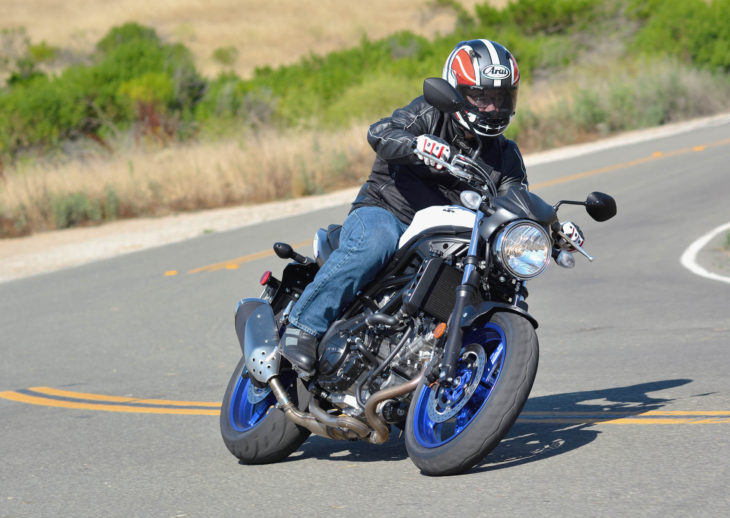
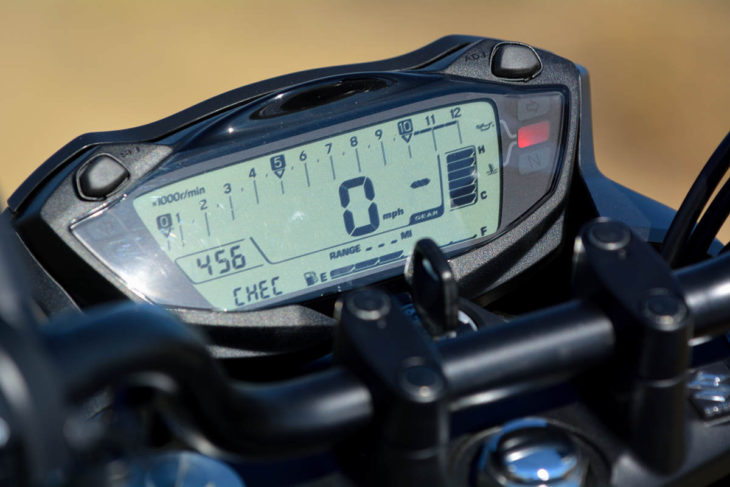

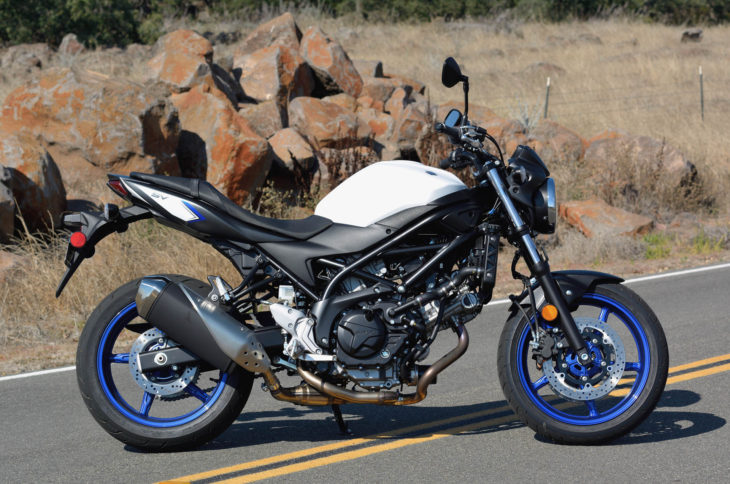
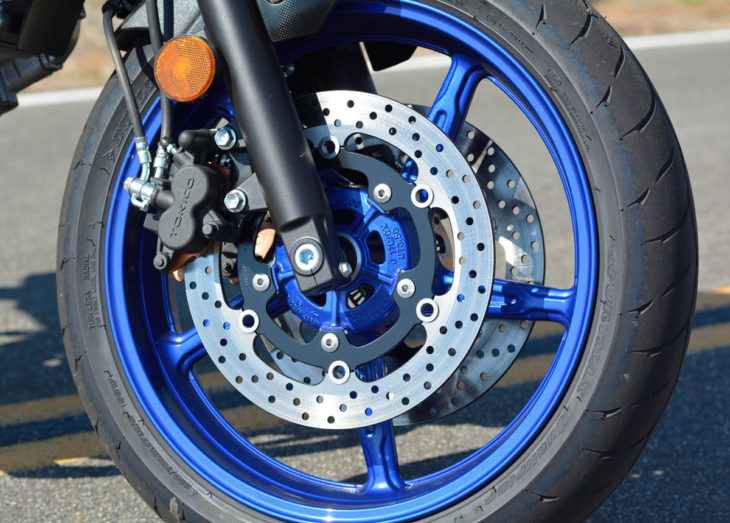
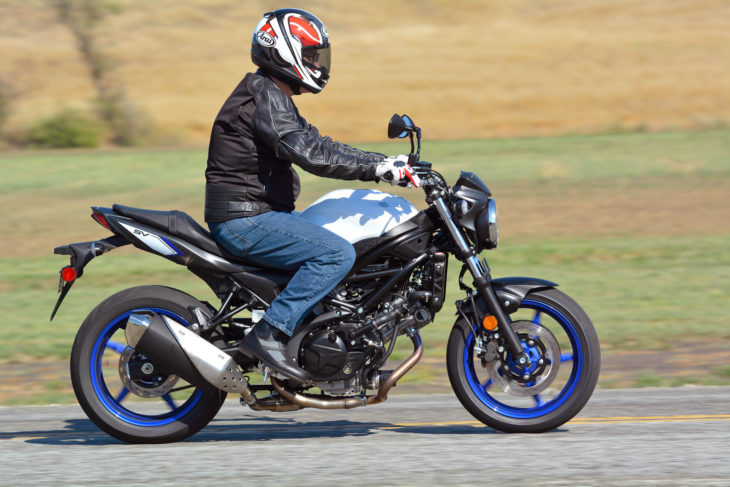






I have an FZ-07. I don’t dislike parallel twins. The 270 degree crank is torquey and makes a cool noise, but the vibrations get to you on long rides, even with the balance shaft. Yamaha has made a very cool engine in a small and powerful package, but the 90 degree v-twin will always be king. And I’ve wanted an SV650 since 2006, and I do like the new one, but I don’t think I like it enough to make a lateral move. Probably will go for the 2017 V-Strom 650 XT instead. Same engine and more versatility. Could always get a Gen 2 SV650 for the track.
You will not regret getting a Strom!
I owned a 2007 SV650K7 back in 2007 and own a 2015 FZ07 today.
I rode both bikes a lot, and prefer the FZ07 by a fair margin.
Same basic platform perhaps, but different in execution.
Ride them back to back, if you haven’t. I found them quite different in character. The SV is definitely more “lively” in feeling, makes more fun noise and more connected/responsive to the rider. The Strom is no slouch, but more smooth/stable – the responsible elder sibling.
I know I can’t tolerate a seat that forces me into the tank. Suzuki offered a “tall seat” for the previous SV (or SFV?) which could help, but their website still doesn’t list any accessories for this 2017 SV (even though the bike has been available for many months). Sargent Seat said they have no plans at this time for a replacement seat for the ’17 SV, and I got no response from an email to Corbin. Some will probably comment that an independent upholstery shop could modify the seat enough to work, but I don’t think it’s worth the risk of buying the bike, first, to find out. I owned an ’03 SV naked, and would have preferred that Suzuki go with a flat/horizontal, 2-piece seat design again. ‘Shame.
I question that the average rider can’t notice 25 lbs. of weight on a 400 lbs. bike. I’d agree with perhaps 7 lbs. Looks like a nice bike, hope the engine upgrades make it to the DL650.
The restyled and updated 2017 V-Strom 650 does have the updated engine, ABS, and TC. I want an SV but I think I’d be more comfortable on the DL.
This new SV650 Scrambler looks rather nice … although not really a scrambler. Whatever, its a whole lot nicer looking than that uber-ugly purple wheel version.
http://www.motorcyclenews.com/news/new-bikes/2016/december/suzuki-sv650-scrambler/
No likey brown seats! Bad memories of CB500T and sticky seat on a Venture Royale Those wheels look blue to me. Uh Oh it’s not that dress color thing going on is it?
Those wheels look blue to me. Uh Oh it’s not that dress color thing going on is it?
They are blue, and they are glorious…
They are the one thing old SV owners many wished they could have from the GladiuSFV.
If you put a brown seat with “tuck and roll” upholstery on any m/c it automatically becomes a “Scrambler”.
Looks like an excellent model including well optimized ergonomy. If they just offer small windshield as option in would be an excellent and tempting choice, even in my advanced age. I had once years back VTR1000 so I can appreciate feel of V-twin; it is exhilarating.
Can’t wait for the comparo with the Kawi and Yamaha. I think all three are winners. These mid range bikes have all the performance that 95% of riders can use on the street and are far less likely to put you in the hospital. Granted if you are heading to the race track or far horizon they might not fill the bill.
I have a 2008 SV that came off Craigslist two years ago with a GSXR shock, Traxxion Dynamics fork kit, and Delkevic slipon. At $2750 it was an amazing bang for the buck bargain. The only real weak point, the brake feel, was solved by the addition of a used R6 Brembo radial master cylinder purchased off Ebay for $75.
The only bike, of many owned, that put as large a smile on my face as the SV was also a 650, my first new motorcycle, a 1966 Triumph TR6R.
Why a standard has the utterly stoopid curved seat is beyond me. No room to move and fits one rider. It’s a horrid idea that gets repeated by many manufacturers. Ducati has now fixed it and Suzuki brings it back. Don’t put a sport subframe on a standard. Just don’t do it. A flatter seat and stubby custom subframe, from the factory, would be much nicer. These engineers are dopes. I sat on it in Daytona and said, NOPE. I’ll take my CB500F. Less power but I beat all the cars on the block with 45 HP just fine.
https://1drv.ms/i/s!AginrQv4c8TljGDZ861ZG-0qfvby
Agree. The seat is one of the worst.
I have a 2006 650 V-Strom, dipped seat stock,
switched to the flatter 1000 seat. (same base, slips on) Makes all the difference.
Sweet looking ride ! Good for a full day at 400 plus miles?
I’m sure the engineers are not dopes. The seat undoubtedly is a result of the marketing dept specifying that the seat height must come in below 31 inches while retaining the current lines.
Same here: Sat on a new SV at the dealer last spring = no deal. I know I can’t tolerate a seat that continuously slides me into the tank. I owned an ’03, and would have preferred that flat, 2-piece seat again.
‘Tried to DELETE this duplicate entry: Didn’t work!
I want to love this bike but it looks like it was conceived in a garage. Compared to an FZ 07 or Guzzi V7III, well, no comparison.
Long time admirer of the SV and multiple owner. Nice to see attention being paid to the middle and smaller displacement models again.
Wonder if Suzuki has ever considered an ‘R’ version of the SV650 or if there would be enough of a market for such an animal. They already have plenty of superior suspension and brake components and tweaking this engine is well understood. This would NOT be another ‘S’ version with bodywork but truly an up-spec machine for the more demanding rider.
I like your thinking here. I have been saying the same thing for a long time. A middle weight twin with quality suspension and brakes would appeal to a lot of riders. Veteran riders, track day riders, club racers etc would all really appreciate this great motor if it came stock with a GSXR front end and a similar quality shock.
I’d ride that. The Ducati 797 is more appealing than the SV650 to me as an experienced rider not looking for horsepower because of its brakes and suspension. I don’t like luxury brands though and would rather ride a Suzuki than a Ducati.
I love luxury brands too … especially Ducati and KTM. But I tend to buy Japanese for their longevity and dependability. Ive had air-cooled Ducatis that required new valve seats after 7k of street and track. My SV track bike never required anything other than oil changes after years of track days. Even the valves stayed in adjustment!
I find it odd that the OEMs don’t make R or S models of budget bikes. They could certainly offer some nice bang for the extra bucks. They could even pocket a few extra bucks for themselves. Pay extra, get sportbike suspension and brake components. It seems like such a no brainer.
Especially since they already have the GSXR600R. Just go to the parts bin and slap those pieces on and call it a day.
Not enough sales volume to split them into smaller segments. They want you to choose the SV650 -or- the GSXR600, but they don’t want the two competing any closer than that.
Niche brands can do it because they’re operating on a smaller scale. They’re not any dealer’s primary brand.
Suzuki produces enough of these worldwide for them to do it. The size of the US market is also big enough to support it. It isn’t a question of scale. While I don’t have any direct expertise in the MC industry, I worked in mass production long enough to feel confident saying that. Your second point is right on the money though if I had to guess. They want people to move up to the GSX-S750 if Terry are looking for more brakes and suspension. The Japanese OEM business model has always been to graduate riders from lesser machines to greater ones. Old habits die hard.
Right now, there is a status quo that the OEMs are happy with. All it would take is one of the big four to break the mold and put out an “R” model. Then the floodgates open.
I continue to assert that the issue is with what people have bought.
Start an online petition of people ready to purchase an SVS/R with 20,000 names and send it to Suzuki of America. Prove to S0A that there is a justifiable market share, and they will likely make a move.
Understand, however that Yamaha has the purchasing advantage when it comes to suspension parts.
Sorry Mick – didn’t look to steal your post (guess great minds think alike). I don’t recall it being up when I make my similar comment.
The second gen SV650 was offered in an S and SF model (half fairing and full). I would love to see an R but Suzuki is still struggling and the market is soft. People also would love to see an FZ-07 R but the point of these bikes is to be cheap. Even $1000 more and you’re in FZ-09 land.
re: “a feature called “Low RPM Assist” that increases engine rpm as you leave a stop to reduce instances of stalling.”
yup, we call that turning up the idle screw on my old carburetted GSXR when teaching girlfriends how to ride.
“girlfriends”?
Variety IS the spice of life. What? Have you only ever ridden one bike?
Please explain how a 10+yr old “v-twin is significantly more expensive to manufacture” than a new design 2, 3 or 4 cylinder. Just saying…
Mixing 2 concepts, I think. Older tooling might be fully amortized (your point, as I understand it), but v-twins undoubtedly contain more parts (separtate cylinders, cams, etc.) and involve more complex/time consuming assembly. The fact that the SV650 carries the same price as the inline twins (which are less expensive to manufacture) may reflect the fact that Suzuki has already recovered the tooling costs..
Not to mention the Kawasaki P2 would also be fully amortized by now.
Also, tooling doesn’t last forever. It must be remade periodically and paid for again.
I have an older DL650 but my “adventure” riding is limited and my DR is more suited for that anyway. So the SV is definitely on my radar as a replacement for the DL and another bike in my garage. Suzuki 650 reliability and function? Check. Big round headlight? Check? Will probably need aftermarket emulators, brakes, seat? Been doing that for 30+ years on Japanese bikes, comes with the territory. But blue wheels? Sure they could be painted or powder coated black, or silver, or gray, but who wants to remove tires and rotors and bearings and seals etc and spend big money. It’s not a deal breaker, but they sure are ugly to me. Almost Gladius-like. EDIT: it looks like the red ABS version has black wheels. Not crazy about red, but it’s better.
So if the ABS model is only available in red, how did you guys get a white one? And why do manufacturers always pick the least desirable color (to me anyway) to pair ABS with?
The Kawasaki looks better in my opinion, but I really like this too. I’d need some seat time to decide which I like best. I’m glad to see this segment come back to life. It had gotten pretty stale for a while.
You are right! We were told initially our test unit would have ABS, but the white unit we received was non-ABS (story corrected).
Glad you didn’t attempt a brake grab test to sample the effectiveness of the ABS.
Me too. Thanks for pointing out the error. Frankly, when I test a bike on dry roads I am typically concentrating on things other than ABS.
I was always surprised at the get up and go above 75mph of my DL650. It just kept accelerating. Beautiful engine/transmission.
My previous 2003 SV650S is one of my favorite bike. Had a blast on track days and backroads. I travel across almost the entire country (Canada) with this bike.
The 2017 SV650 is an entire different story, for me at least. From an affordable, fun middleweight bike, it became a smaller bike that lost the nice exhaust note and feel cheaper. True, Suzuki’s transmission are the best.
Have to say that i did just one demo ride with the 2017 SV. I was very disappointed. I was hoping to relive the greats moments i had with the SV650S.
The white/black/blue version you’ve got looks great. The two-piston calipers are probably OK – they did a sufficient job of slowing down my DL1000 over 11 years and 90,000 km of riding. Maybe a little lacking in feel. I just can’t help but wonder how much cost or weight it would add to put some 4-piston calipers on this thing. The Yamaha’s got them. Also get rid of the goofy cross-over brake line – split it up higher.
Does this iteration of the SV have at least basic cartridge forks? I think in a 2017 model, using damper-rod forks is hopelessly old-school. They’re a huge compromise and never deliver the ride or handling one would like. State of the art up until the 70s, even 80s maybe, but shouldn’t be used these days, IMO.
Those are damper rod forks I’m sure.
I’ve had Racetech springs and emulators in damper rod forks, and they gave up nothing to most OEM cartridge forks I’ve owned it sampled. Outperformed them in most cases.
Lordy, you must have sampled some seriously rotten cartridges to think emulators come anywhere close – oh wait, that IS Japanese suspension regardless of the price point…
There are proper cartridge solutions for the SV/R3/FZ07 and the like that cost 500-600; OHlins NIX-22, Andreani, and Matris F15 but they all need varying degrees of “help” to be used effectively on the street.
All of those are much better quality than your typical OEM budget cartridges. I agree that emulators will not match a premium suspension product.
I’m pretty happy with emulator performance on bikes that end up getting them. In most cases they’re older bikes or budget rides that are limited elsewhere, such as brakes. Having said that I think the SV650 is one bike that has always gained a lot from emulators.
Apparently the Showa Dual Bending Valve forks in the latest Harleys and retro Hondas is just an OEM emulator on a damper rod. I’ve been trying to find more tech info on this, with little success so far.
Of the twenty-some-odd new bikes I’ve owned my Race Tech/Penske/Galfer/Yosh-modded naked SV650 is still one of my five all-time favorites. On top of the usual track days, 110-mile daily commute and weekend ripping around, the addition of a set of Ventura luggage enabled us to throw my wife on the back and do two weeks across the western U.S. and Canada, and that little 650 was absolutely fine. Never any lack of power, and I also had GSX-R1000s, GSX-R750s, and ST1300s in that same time-frame.
The bike just works. It does anything you want, within reason, while always being fun, reliable, affordable, comfortable, and simple. It’s also a real giant killer in the canyons. It’s the exact bike half the people on this site have been clamoring for ever since Suzuki screwed up the original SV650, leaving the market with a large void that has only recently begun to be filled with things like the FZ-07.
There is just no way not to have a good time riding a naked SV650. Even bog-stock it still works surprisingly well, at least until you get to hardcore track days and serious canyon racing. Throw a couple of key mods at it and not only does it become an absolute blast at the track but also one the very best real-world sporty street bikes ever made.
re: “Suzuki screwed up the original SV650”
BPE, Biggest Poochscrew Ever…!
Agree 100%. My naked ’03 SV650 (bought new) is the one I’ll never sell. Absolutely love it.
As far as looks go the naked kawasaki wins in this class. Honda has the only 4 Cyl 650 but weighs about 45 lbs more than the other competitors. My big question is what is the braking perfomance of these bikes and can the problem be fixed.
I haven’t ridden the these newest iterations of the Suzuki and Kawasaki, but back in the day when the SV650 and Ninja 650 were duking it out for marketshare, you could make vast improvements with just the addition of steel braided brake lines and a more aggressive set of brake pads.
I really like this bike and it’s on my short list to add to the garage one of these days along with the FJ07 if it ever gets here and the NC700 Honda. MIght have to look at the new Z650 as well. My nephew has had a couple SVs and they have been bullet proof, plus the price is great.
Dont like how the seat slopes but it may not be an issue for my height, as I usually sit up against most tanks anyway.
Good job Suzuki
Although small in number recall the WERA F2 class. A perfect fit!